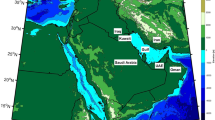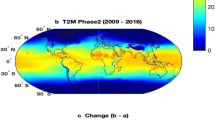Abstract
Bangladesh is sensitive to weather and climate extremes, which have a serious impact on agriculture, ecosystem, and livelihood. However, there is no systematic investigation to explore the effect of climate modes on temperature extremes over Bangladesh. A total of 11 temperature extreme indices based on the daily maximum and minimum temperature data for 38 years (1980–2017) have been calculated. Cross-wavelet transform and Pearson correlation coefficient have been used to identify the relationship between temperature extremes and three climate modes namely El Niño Southern Oscillation (ENSO), Indian Ocean Dipole (IOD), and North Atlantic Oscillation (NAO). Detrended fluctuation analysis (DFA) method was applied to predict the long-term relationship among temperature indices. Results showed that warm (cold) temperature extreme indices increased (decreased) significantly. There was a significant upward trend in the diurnal temperature range and tropical nights except for growing season length. ENSO and IOD had a strong negative impact on warm temperature indices, whereas NAO had a strong negative influence on variability temperature indices in Bangladesh. Temperature extreme had a long-term relationship based on DFA (a > 0.5), implying that the temperature extremes will remain their present trend line in the future period. The Poisson regression model showed that the highest probability (65%) of having a 2–4 warm spell duration indicator (days/decade) is consistent with the observation, which is shown in the cross-wavelet transform and spatial analysis.















Similar content being viewed by others
Data availability
The datasets and code will be available from the corresponding author on reasonable request.
References
Abiodun BJ, Lawal KA, Salami AT, Abatan AA (2013) Potential influences of global warming on future climate and extreme events in Nigeria. Reg Environ Change 13:477–491
Aguilar E, Peterson TC, Obando PR et al (2005) Changes in precipitation and temperature extremes in Central America and northern South America, 1961–2003. J Geophys Res Atmos 110:1–15
Alexander LV, Zhang X, Peterson TC et al (2006) Global observed changes in daily climate extremes of temperature and precipitation. J Geophys Res Atmos 111:1–22
Allen CD, Macalady AK, Chenchouni H et al (2010) A global overview of drought and heat-induced tree mortality reveals emerging climate change risks for forests. For Ecol Manag 259:660–684
Bandyopadhyay S, Kanji S, Wang L (2012) The impact of rainfall and temperature variation on diarrheal prevalence in Sub-Saharan Africa. Appl Geogr 33:63–72
Benestad RE, Haugen JE (2007) On complex extremes: flood hazards and combined high spring-time precipitation and temperature in Norway. Clim Change 85:381–406
Ciais P, Reichstein M, Viovy N et al (2005) Europe-wide reduction in primary productivity caused by the heat and drought in 2003. Nature 437:529–533
Coumou D, Rahmstorf S (2012) A decade of weather extremes. Nat Clim Change 2:491–496
Coumou D, Robinson A, Rahmstorf S (2013) Global increase in record-breaking monthly-mean temperatures. Clim Change 118:771–782
Craparo ACW, Van Asten PJA, Läderach P et al (2015) Coffea arabica yields decline in Tanzania due to climate change: global implications. Agric for Meteorol 207:1–10
Das S, Wahiduzzaman M (2021) Identifying meaningful covariates that can improve the interpolation of monsoon rainfall in a low-lying tropical region. Int J Climatol. https://doi.org/10.1002/joc.7316
Dastagir MR (2015) Modeling recent climate change induced extreme events in Bangladesh: a review. Weather Clim Extrem 7:49–60
Easterling DR, Meehl GA, Parmesan C et al (2000) Climate extremes: observations, modeling, and impacts. Science 289:2068–2075
Endfield GH (2012) The resilience and adaptive capacity of social-environmental systems in colonial Mexico. Proc Natl Acad Sci U S A 109:3676–3681
Fraedrich K, Blender R (2003) Scaling of atmosphere and ocean temperature correlations in observations and climate models. Phys Rev Lett 90:4
Gao X, Zhao Q, Zhao X et al (2017) Temporal and spatial evolution of the standardized precipitation evapotranspiration index (SPEI) in the Loess Plateau under climate change from 2001 to 2050. Sci Total Environ 595:191–200
Guan Y, Zhang X, Zheng F, Wang B (2015) Trends and variability of daily temperature extremes during 1960–2012 in the Yangtze River Basin, China. Glob Planet Change 124:79–94
Guo E, Zhang J, Wang Y et al (2019) Spatiotemporal variations of extreme climate events in Northeast China during 1960–2014. Ecol Indic 96:669–683
Hasan MA (2013) Predicting change of future climate extremes over Bangladesh in high-resolution climate change scenarios. In: 4th International Conference on Water and Flood Management. Institute of Water and Flood Management, BUET, Dhaka-1000, Bangladesh, pp 583–590
Hidalgo-Muñoz JM, Argüeso D, Gámiz-Fortis SR et al (2011) Trends of extreme precipitation and associated synoptic patterns over the southern Iberian Peninsula. J Hydrol 409:497–511
Islam AT, Shen S, Yang S et al (2019) Assessing recent impacts of climate change on design water requirement of Boro rice season in Bangladesh. Theor Appl Climatol 138:97–113. https://doi.org/10.1007/s00704-019-02818-8
Islam ARMT, Nafiuzzaman M, Rifat J, Rahman MA, Chu R, Li M (2020a) Spatiotemporal variations of thunderstorm frequency and its prediction over Bangladesh. Meteorol Atmos Phys. https://doi.org/10.1007/s00703-019-00720-6
Islam ARMT, Ahmed I, Rahman MS (2020b) Trends in cooling and heating degree-days overtimes in Bangladesh? An investigation of the possible causes of changes. Nat Hazards 101:879–909. https://doi.org/10.1007/s11069-020-03900-5
Jiang Z, Song J, Li L et al (2012) Extreme climate events in China: IPCC-AR4 model evaluation and projection. Clim Change 110:385–401
Khan MJU, Islam AKMS, Das MK et al (2019) Observed trends in climate extremes over Bangladesh from 1981 to 2010. Clim Res 77:45–61
Klein Tank AMG, Peterson TC, Quadir DA et al (2006) Changes in daily temperature and precipitation extremes in central and south Asia. J Geophys Res Atmos 111:006316
Li M, Chu R, Islam ARMT et al (2020) Attribution analysis of long-term trends of aridity index in the Huai River Basin Eastern China. Sustainability 12(5):1743. https://doi.org/10.3390/su12051743
Lin P, He Z, Du J et al (2017) Recent changes in daily climate extremes in an arid mountain region, a case study in northwestern China’s Qilian Mountains. Sci Rep 7:1–15
Ma ZG, Fu CB, Ren XB, Yang C (2003) Trends of annual extreme temperature and its relationship to regional warming in Northern China. Acta Geograph Sin 58:11–20
Mahmud K, Saha S, Ahmad T, Satu US (2018) Historical trends and variability of temperature extremes in two climate vulnerable regions of Bangladesh. J Bangladesh Agric Univ 16:283–292
Mann HB (1945) Non-parametric test against trend. Econometrica 13:245–259
Omondi PA, Awange JL, Forootan E et al (2014) Changes in temperature and precipitation extremes over the Greater Horn of Africa region from 1961 to 2010. Int J Climatol 34:1262–1277
Pant H (2017) Case study of uttarakhand in perspective of extreme climatic events: fire, ecosystem and livelihoods. Climate change research at universities: addressing the mitigation and adaptation challenges. Springer International Publishing, pp 519–531
Perez C, Jones EM, Kristjanson P et al (2015) How resilient are farming households and communities to a changing climate in Africa? A gender-based perspective. Glob Environ Change 34:95–107
Piccarreta M, Lazzari M, Pasini A (2015) Trends in daily temperature extremes over the Basilicata region (southern Italy) from 1951 to 2010 in a Mediterranean climatic context. Int J Climatol 35:1964–1975
Rahman MS, Islam ARMT (2019) Are precipitation concentration and intensity changing in Bangladesh overtimes? Analysis of the possible causes of changes in precipitation systems. Sci Total Environ 690:370–387. https://doi.org/10.1016/j.scitotenv.2019.06.529
Rahman MR, Lateh H (2016) Spatio-temporal analysis of warming in Bangladesh using recent observed temperature data and GIS. Clim Dyn 46:2943–2960
Rammig A, Mahecha MD (2015) Ecology: Ecosystem responses to climate extremes. Nature 527:315–316
Reich PB, Sendall KM, Rice K et al (2015) Geographic range predicts photosynthetic and growth response to warming in co-occurring tree species. Nat Clim Change 5:148–152
Schmidli J, Frei C (2005) Trends of heavy precipitation and wet and dry spells in Switzerland during the 20th century. Int J Climatol 25:753–771
Shahid S, Wang XJ, Bin HS et al (2016) Climate variability and changes in the major cities of Bangladesh: observations, possible impacts and adaptation. Reg Environ Change 16:459–471
Sheikh MM, Manzoor N, Ashraf J et al (2015) Trends in extreme daily rainfall and temperature indices over South Asia. Int J Climatol 35:1625–1637
Smith MD (2011) The ecological role of climate extremes: Current understanding and future prospects. J Ecol 99:651–655
Sun W, Mu X, Song X et al (2016) Changes in extreme temperature and precipitation events in the Loess Plateau (China) during 1960–2013 under global warming. Atmos Res 168:33–48
Tong S, Li X, Zhang J et al (2019) Spatial and temporal variability in extreme temperature and precipitation events in Inner Mongolia (China) during 1960–2017. Sci Total Environ 649:75–89
Uddin MJ, Hu J, Islam ARMT et al (2020) A comprehensive statistical assessment of drought indices to monitor drought status in Bangladesh. Arab J Geosci 13:323
Ullah S, You Q, Ullah W et al (2019) Observed changes in temperature extremes over China–Pakistan Economic Corridor during 1980–2016. Int J Climatol 39:1457–1475
Wahiduzzaman (2021) Major floods and tropical cyclones over Bangladesh: clustering from ENSO timescales. Atmosphere 12(6):692
Wahiduzzaman M, Luo JJ (2021) A statistical analysis on the contribution of El Niño-Southern Oscillation to temperature and rainfall over Bangladesh. Meteorol Atmos Phys 133:55–68
Wahiduzzaman M, Yeasmin A (2019) Statistical forecasting of tropical cyclone landfall activities across the North Indian Ocean rim. Atmos Res 227:89–100
Wahiduzzaman M, Yeasmin A, Luo JJ (2020a) Seasonal movement prediction of tropical cyclone over the North Indian Oceans by using atmospheric climate variables in statistical models. Atmos Res 245:105089
Wahiduzzaman M, Yeasmin A, Luo JJ, Ali MA, Bilal M, Qiu Z (2020b) Statistical approach to observe the atmospheric density variations using Swarm Satellite data. Atmosphere 10:2537
Wang X, Li Y, Chen Y et al (2018) Temporal and spatial variation of extreme temperatures in an agro-pastoral ecotone of northern China from 1960 to 2016. Sci Rep 8:1–14
You QL, Ren GY, Zhang YQ et al (2017) An overview of studies of observed climate change in the Hindu Kush Himalayan (HKH) region. Adv Clim Change Res 8:141–147
Yue S, Pilon P (2004) A comparison of the power of the t test, Mann-Kendall and bootstrap tests for trend detection. Hydrol Sci J 49:21–37
Zanchettin D, Rubino A, Matei D et al (2013) Multidecadal-to-centennial SST variability in the MPI-ESM simulation ensemble for the last millennium. Clim Dyn 40:1301–1318
Acknowledgements
The authors would like to acknowledge the Bangladesh Meteorological Department for providing the dataset for this research. Authors are grateful to two anonymous reviewers and Research Society (https://researchsociety20.org/) team. M. Wahiduzzaman was supported by a Nanjing University of Information Science and Technology Start-Up fund.
Author information
Authors and Affiliations
Corresponding authors
Ethics declarations
Conflict of interest
None.
Additional information
Responsible Editor: Emilia Kyung Jin.
Publisher's Note
Springer Nature remains neutral with regard to jurisdictional claims in published maps and institutional affiliations.
Rights and permissions
About this article
Cite this article
Uddin, M.J., Wahiduzzaman, M., Islam, A.R.M.T. et al. Impacts of climate modes on temperature extremes over Bangladesh using statistical methods. Meteorol Atmos Phys 134, 24 (2022). https://doi.org/10.1007/s00703-022-00868-8
Received:
Accepted:
Published:
DOI: https://doi.org/10.1007/s00703-022-00868-8




